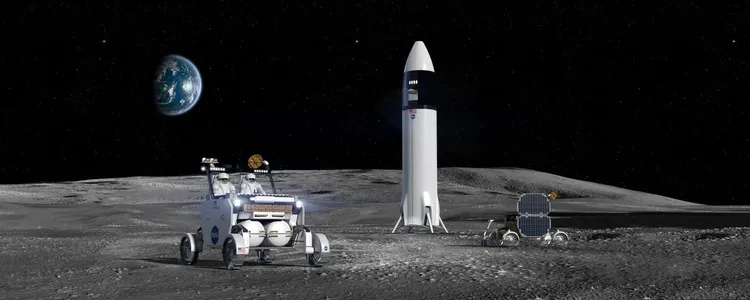NASA has picked three companies to develop a new lunar racer car that Artemis astronauts will use to traverse the Moon in the 2030s.
It will help astronauts reach mysterious, never-before-explored destinations, that are deemed unreachable by foot.
The lunar terrain rover (LTV) will be an essential string in Nasa’s bow in terms of scientific research and exploring the Moon’s south pole during the Artemis V mission.
The south pole is, scientists believe, the most promising location for water-based ice, which will be key to future human habitation on the Moon.
The concentration of precious lunar materials in the polar region is also of interest to the US government, experts say.
We will use the LTV to travel to locations we might not otherwise be able to reach on foot, increasing our ability to explore and make new scientific discoveries.
Jacob Bleacher, chief exploration scientist at Nasa
Intuitive Machines, Lunar Outpost and Venturi Astrolab have been tasked with developing an autonomous vehicle as part of a $4.6billion contract over the next 13 years.
READ MORE ON THE MOON
The trio will now launch a year-long study to develop a system that meets Nasa’s requirements.
Nasa has said that the Moon car must be able to accommodate two suited astronauts, and withstand extreme conditions.
Temperatures can drop to as low as -230 degrees Celsius (-382 degrees Fahrenheit in shadowed regions of the lunar south pole.
It must also be able to work autonomously, so controllers on Earth can continue to explore the lunar surface without astronauts.
Most read in Science
For this, the vehicle must be kitted out with a robotic arm that will allows controllers to perform scientific tests.
“We will use the LTV to travel to locations we might not otherwise be able to reach on foot, increasing our ability to explore and make new scientific discoveries,” Jacob Bleacher, chief exploration scientist in the Nasa Exploration Systems Development Mission Directorate, said in a statement.
“With the Artemis crewed missions, and during remote operations when there is not a crew on the surface, we are enabling science and discovery on the Moon year-round.”
Intuitive Machines, one of the companies behind the upcoming LTV, built the Odysseus Moon lander that suffered an awkward lunar touchdown in February.
Running on Moon time
Nasa’s Artemis V mission in 2029 will see two astronauts land on the Moon to explore, and another two astronauts set up the ESA’s refuelling module onboard Gateway – the first-ever lunar space station.
In 2026, Nasa will launch its Artemis III mission, the first human assignment on the Moon since Apollo 17.
The third Artemis mission forms part of a decade-long programme that is hoped to culminate with a permanent lunar base.
Yesterday, the White House reportedly directed Nasa to create a standard Moon time for all nations, following a similar proposal by the European Space Agency (ESA) last year.
Space-faring nations currently use their own time zones when performing lunar missions.
But scientists have warned that this won’t be sustainable in a future where humans are establishing permanent living quarters – let alone when grand plans for a lunar railway network unfold.
An internal memo, reported by Reuters, has revealed plans for a Nasa-led Coordinated Lunar Time (LTC) to be in place by the end of 2026.
READ MORE SUN STORIES
Like the US, China has its own plans for a lunar research facility, which it has already agreed to share with Egypt, Venezuela, South Africa, Pakistan and Azerbaijan.
As things stand today, China is aiming to establish its Disneyland-sized International Lunar Research Base (ILRS) no earlier than 2028.
Find out more about science
Want to know more about the weird and wonderful world of science? From the Moon to the human body, we have you covered…












